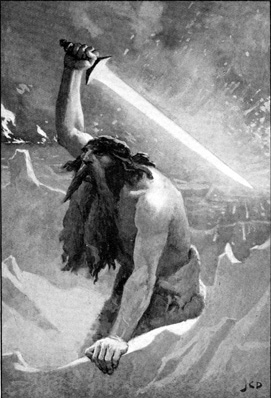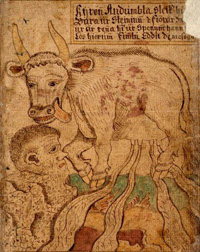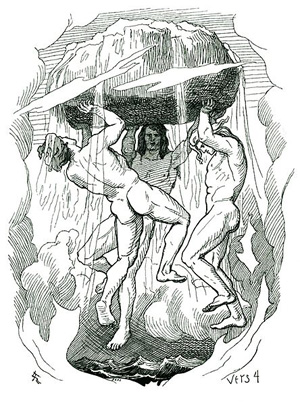These tales have existed for thousands of years in the form of poems, songs and stories until put into written form in the early 11th century. Though several authors attempted to preserve them our “best” source is Snorri Sturluson’s Prose Edda. This is the creation story. This is the first of the 32+ Norse Myths. My main source is the “The Norse Myths” by Kevin Crossley-Holland.
 Burning ice, biting flame; that is how life began. In the south is a realm called Muspell. That region flickers with dancing flames. It seethes and it shines. No on can endure it except to those born into it. Black Surt is there; he sits on the furthest reach of that land, brandishing a flaming sword; he is already waiting for the end when he will rise and savage the gods and whelm the whole work with fire.
Burning ice, biting flame; that is how life began. In the south is a realm called Muspell. That region flickers with dancing flames. It seethes and it shines. No on can endure it except to those born into it. Black Surt is there; he sits on the furthest reach of that land, brandishing a flaming sword; he is already waiting for the end when he will rise and savage the gods and whelm the whole work with fire.
In the north is a realm called Niflheim. It is packed with ice and covered with vast sweeps of snow. In the heart of that region lies the spring Hvergelmir and that is the source of eleven rivers named the Elivagar: they are cool Svol and Gunnthra the defiant, Fjorm and bubbling Fimbulthul, fearsome slid and storming Hrid, Sylg, Ylg, broad Vid and Leipt which streaks like lightning, and freezing Gjoll.
Between these realms there once stretched a huge and seeming emptiness; this was Ginnungagap. The rivers that sprang from Hvergelmir streamed into the void. The yeasty venom in them thickened and congealed like slag, and the rivers turned into ice. That venom also spat out drizzle-an unending dismal hagger that, as soon as it settled, turned into rime. So it went on until all the northern part of Ginnungagap was heavy with layers of ice and hoar frost, a desolate place haunted by gusts and skuthers of wind.
Just as the northern part was frozen, the southern was molten and glowing, but the middle of Ginnungagap was as mild as hanging air on a summer evening. There, the warm breath drifting north from Muspell met the rime from Niflheim; it touched it and played over it and played over it, and the ice began to thaw and drip. Life quickened in those drops, and they took the form of a giant. He was called Ymir.
 Ymir was a frost giant; he was evil from the first. While he slept, he began to sweat. A man and woman grew out of the ooze under his left armpit, and one of his legs fathered a son and on the other leg. Ymir was the forefather of all the frost giants, and they called him Aurgelmir. As more of the ice in Ginnungagap melted, the fluid took the form of a cow. She was called Audumla. Ymir fed off the four rivers of milk that coursed from her teats, and Audumla fed off the ice itself. She licked the salty blocks by the evening of the first day a man’s hair had come out of the ice. Audumla licked more and by the evening of the second day a man’s head had come. Audumla licked again and by the evening of the third day the whole man had come. His name was Buri.
Ymir was a frost giant; he was evil from the first. While he slept, he began to sweat. A man and woman grew out of the ooze under his left armpit, and one of his legs fathered a son and on the other leg. Ymir was the forefather of all the frost giants, and they called him Aurgelmir. As more of the ice in Ginnungagap melted, the fluid took the form of a cow. She was called Audumla. Ymir fed off the four rivers of milk that coursed from her teats, and Audumla fed off the ice itself. She licked the salty blocks by the evening of the first day a man’s hair had come out of the ice. Audumla licked more and by the evening of the second day a man’s head had come. Audumla licked again and by the evening of the third day the whole man had come. His name was Buri.
Buri was tall and strong and good-looking. In time he had a son called Bor and Bor married a daughter of Bolthor, one of the frost giants. Her name was Bestla and she mothered three children, all of the them sons. The first was Odin, the second was Vili, and the third was Ve.
All this was in the beginning, before there were waves of sand, the sea’s cool waves, waving grass. There was no earth and no heaven above; only Muspell and Niflheim and, between them, Ginnungagap.
The three sons of Bor had no liking for Ymir and the growing gang of unruly, brutal frost giants; as time went on, they grew to hate them. At last they attacked Ymir and killed him. His wounds were like springs; so much blood streamed from them, and so fast, that the flood drown all the frost giants except Bergelmir and his wife. They embarked in their boat-it was made of hollowed tree trunk-and rode on a tide of gore.
Odin and Vili and Ve hoisted the body of the dead frost giant on to their shoulders and carted it to the middle of Ginnungagap. That is where they made the world from his body. They shaped the earth from Ymir’s flesh and the mountains from his unbroken bones; from his teeth and jaws and the fragments of his shattered bones they made rocks and boulders and stones.
Odin and Vili and Ve used the welter of blood to make landlocked lakes and to make the sea. After they have formed the earth, they laid the rocking ocean in a ring right around it. And it is so wide that most men would dismiss the every idea of crossing it.
 Then the three brothers raised Ymir’s skull and made the sky from it and placed it so that it’s four corners reached to the ends of the earth. They set a dwarf under each corner, and their names are East and West and North and South. Then Odin and Vili and Ve seized on the sparks and glowing embers from Muspell and called them sun and moon and stars; they put them high in Ginnungagap to light heaven above and earth below. In this way the brothers gave each star its proper place; some were fixed in the sky, others were free to follow the paths appointed form them.
Then the three brothers raised Ymir’s skull and made the sky from it and placed it so that it’s four corners reached to the ends of the earth. They set a dwarf under each corner, and their names are East and West and North and South. Then Odin and Vili and Ve seized on the sparks and glowing embers from Muspell and called them sun and moon and stars; they put them high in Ginnungagap to light heaven above and earth below. In this way the brothers gave each star its proper place; some were fixed in the sky, others were free to follow the paths appointed form them.
The earth was round and lay within the ring of the deep sea. Along the strand the sons of Bor marked out tracts of land and gave them to the frost giants and the rock giants: and there, in Jotunheim, the giants settled and remained. They were so hostile that the three brothers built an enclosure further inland around a vast area of the earth. They shaped it out of Ymir’s eyebrows, and called it Midgard. The sun warmed the stones in thee earth there, and the ground was green with sprouting leeks. The sons of Bor used Ymir’s brains as well; they flung them up into the air and turned them into ever kind of cloud.
One day, Odin and Vili and Ve were striding along the frayed edge of the land, where the earth meets the sea. They came across two fallen trees with their roots ripped out of the ground; one was an ash, the other an elm. Then the sons of Bor raised them and made from them the first man and woman. Odin breathed into them the spirit of life; Vili offered them sharp wits and feeling hearts; and Ve gave them the gifts of hearing and sight. The man was called Ask and the women Embla and races of men are descended from them.
One of the giants living in Jotunheim, Narvi, had a daughter called Night who was as dark eyed, dark haired and swarthy as the rest of her family. She married three times. Her first husband was a man called Naglfari and their son was Aud; her second husband was Annar and their daughter was Earth; and her third husband was shining Delling who was related to the sons of Bor. Their son was Day and, like all his father’s side of the family, Day was radiant and fair of face.
Then Odin took Night and her son Day, sat them in horse-drawn chariots, and set them in the sky to ride round the world every two half-days. Night leads the way and her horse is frosty-maned Hrimfaxi. Day’s horse is Skinfaxi; he has a gleaming mane that lights up sky and earth alike.
A man called Mundilfari living in Midgard had two children and they were so beautiful that he called his son Moon and his daughter Sun; Sun married a man called Glen. Odin and his brothers and their offspring, the Aesir, were angered at such daring. They snatched away both children and placed them in the sky to guide the chariots of the sun and moon- the constellations made by the sons of Bor to light the world out of the sparks from Muspell.
Moon leads the way. He guides the moon on its path and decides when he will wax and wane. He does not travel alone, as you can see if you look into the sky; for Moon in turn plucked two children form Midgar, Bil and Hjuki, who father is Vidfinn. They were just walking away from the well Byrgir, carrying between them the water cask Soeg on the pole Simul, when Moon swooped down and carried them off.
Sun follows behind. One of her horses is called Arvak because he rises so early, and the other Alsvid because he is immensely strong. The Aesir inserted iron-cold bellows under their shoulder-blades to keep them cool. Sun always seems to be in a great hurry, and that is because she is chased by Skoll, the wolf who is always snapping and growling close behind her. In the end he will catch her. And the wolf that races in front of Sun is called Hati; he is after Moon and will run him down in the end. Both wolves are the sons of an aged giantness who lived in Iron Wood, east of Midgard.
After the sons of Bor had made the first man and woman, and set Night and Day, Moon and Sun in the sky, they remembered the maggots that had squirmed and swarmed in Ymir’s flesh and crawled over the earth. Then they gave them wits and the shape of men, but they live under the hills and mountains in rocky chambers and grottoes and caverns. These man-like maggots are called dwarfs. Modsognir is their leader and his deputy is Durin.
So the earth was fashioned and filled with men and giants and dwarfs, surrounded by the sea and covered by the sky. Then the sons of Bor built their own realm of Asgard-a mighty stronghold, a place of green plains and shining palaces high over Midgard. The two regions were linked by Bifrost, a flaming rainbow bridge; it was made of three colors with magic and great skill, and it is wonderfully strong. All the Aesir, the guardians of men, crossed over and settled in Asgard. Odin, Allfather, is the oldest and greatest of them all; there are twelve divine gods and twelve divine goddesses, and a great assembly of other Aesir. And this was the beginning of all that has happened, remembered or forgotten, in the regions of the world.
And all that has happened, and all the regions of the world, lie under the branches of the ash Yggdrasill, greatest and best of trees. It soars over all that is; its three roost delve into Asgard and Jotunheim and Niflheim, and there is a spring under each. A hawk and eagle sit in it, a squirrel scurries up and down it, deer leap within it and nibble at it, a dragon devours it, and it is sprinkled with dew. It gives life to itself, it gives life to the unborn. The winds whirl round it and Yggdrasill croons or groans. Yggdrasill always was and is and will be.

Gabriel
Hi, I am just trying to get clarification, so, this work is not yours, it is a translation by Kevin Crossley-Holland? If so, do you have a way of helping me to find his actual document that says this? I am trying to make a research paper on the topic, thank you.
– Gabriel (gabe4440@gmail.com)
N
Correct, I did not write the Norse Myths and I do not know the language(s) they were spoken or written in. Google is your friend.
Jessica
I know this is years later, but just in case someone else is curious, it is in the form of a book called Norse Mythology. It is one of my personal favorites which is why I love this site so much when I’m not at home.
J. Copeland
Although I would agree that “Caucasian” people should have knowledge of the Gods, I may suggest that a person like yourself should research history in general. If you had invested time into researching history before Christianity you would find most “Caucasian” people originate from areas that practiced this form of paganism, be it Anlgo-Saxon, Germanic, or Norse. It is not a matter of claiming a heritage that is not one’s own, because it is, but remembering a lost belief system buried by the adoption of modern day religious teachings. Mr. Sheppard thank you for sharing the myths of our ancestors from a time long forgotten by most.
Dragon Smith
I like this site for it has helped me learn Norse mythology including the deities that where worshiped (even though I am now worshiping them as well as Greek/Roman and Egyptian). I am Wiccan and a polytheistic person. Monotheism doesn’t agree with me for some reason. I have been meaning to read up on the norse myths but haven’t had time to, until now.
Thanks!!!!!!!!
Troðari
Generally, when people truly mean no offense they have no need to say so, because they haven’t insinuated anything offensive.
Whether because you’re trying to pad out your message to be more palatable, or because you simply didn’t write clearly, your meaning and intent aren’t quite clear. Either you’re a white supremacist making a veiled case that this mythology somehow supports that viewpoint, or you’re a POC suggesting that whites mind their own business.
Either way, you seem to be arguing for racial separatism from a position of ignorance about Ancient Norse culture, which every shred of evidence we have indicates was deeply assimilationist and syncretic.
That’s pretty offensive to their cultural legacy.
Jessica
“Caucasian” people actually come from the Caucasus Mountains which are located in Eurasia located between Black Sea and the Caspian Sea, the countries that it runs through are Russia, Azerbaijan, Georgia, Abkhazia. These countries are also NOWHERE near Scandinavia (Norway, Iceland, Denmark, Sweden and Greenland). People of European decent come from more than one place and not all of them are Scandinavian. So, what you should say, and still MEAN to be offensive, is that people of Scandinavian decent (such as myself) should study OUR ancestors and their cultures. Now, I would also like to add in here that I do have Sub-Saharan African in me, very little, but I do have some in me. So, according to what you said I should be studying Sub-Saharan culture as well. Let’s not forget, Russian, Georgian, German, Italian, Greek, British, Jewish, and the list goes on. The fact of the matter is this, YOU have nowhere to tell me what I am let alone what I am allowed to study.
I CHOOSE to study Asatru and to follow the old ways because it is what I believe is true, not because I or anyone else should HAVE to study any one thing.